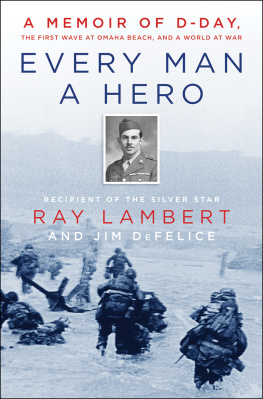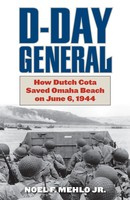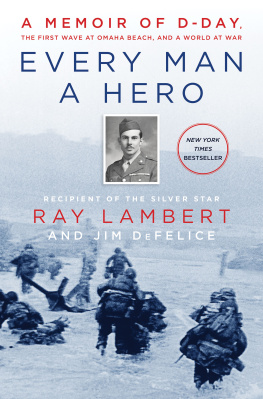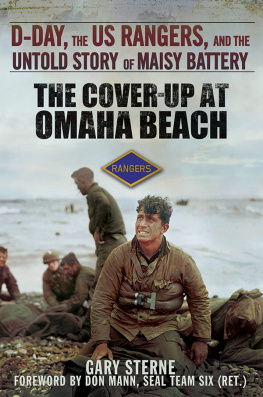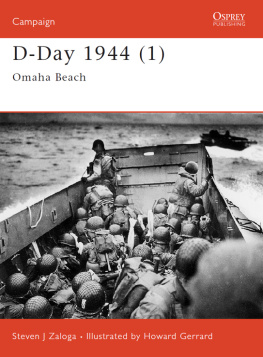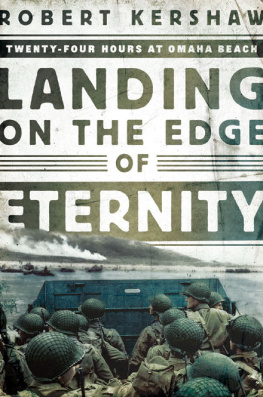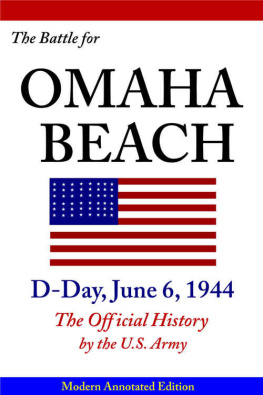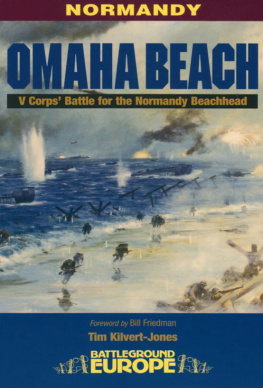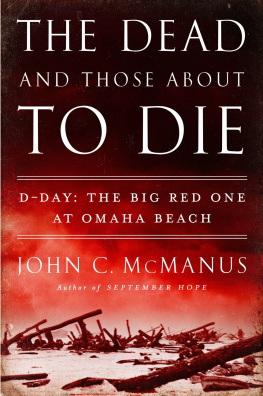Table of Contents
Landmarks
Ray has a large and generous group of friends and family, and their love and support truly made this book possible. Thanks first and foremost to Barbara, Rays wife, who helped with a variety of tasks directly related to the book and was a gracious, patient, and welcoming host as the interviews progressed. As Ray notes in the book, shes the reason hes still going strong at ninety-eight.
Besides being great friends, Rays neighbors, Gijsbertus VanDomselaar, otherwise known as Bert, and his wife, Elly, were a tremendous help to him when he was first organizing his memories.
Ray would also like to specially thank Major Christophe Coquel of the French Gendarmerie. Christophe has gone out of his way to make things easy for Rays visits to Normandy, and had been a tireless supporter of the 16th Infantry and the Big Red One for many years.
Critical research on this book was provided by Ray Fashona, an excellent writer as well as researcher, who did much of the footwork in the preliminary stages, tracking down survivors of the Battle for Normandy and their families.
Debra Scacciaferro was again of immense assistance, researching different aspects of the battles and medical history. She also spent considerable time sorting through photographs and official U.S. Army documents to augment my research. In addition, Debra provided valuable feedback as the manuscript was being prepared.
In France, Jims friend Dianne Condon-Boutier (now with Fat Thelma Tours, www.france-vacations-made-easy.com) was a dynamic, tireless, and truly phenomenal guide, translator, and sounding board in Normandy, literally opening doors to hidden bunkers and normally closed museums. Jims friend Patrick Ober was a great companion and resource, as well as a cheerful translator and sounding board.
Stphane Leguennec of La Colline was a gracious and accommodating host in Bayeux. Label West Tours helped facilitate Jims arrangements with great efficiency.
Many museum and library directors and staffs played an important role in providing background and information. John Long at the National D-Day Museum was especially helpful and extremely gracious as a host during the early stages of research on the book. Jim was assisted once again by the Ramapo Catskill Library System and the staff at Albert Wisner Library, who obtained many difficult-to-find books that added to this project.
Our editor at William Morrow, Peter Hubbard, was instrumental in the birth of this book. Not only did he suggest the topic, he tirelessly pushed and supported it, and accompanied Jim on an early trip to work with Ray.
Peters assistant, Nick Cadillac Amphlett, was a critical resource at the publishing house and while we were doing research. Vice President of Publicity Sharyn Rosenblum and her staff were wonderful in their support.
Also at William Morrow, sincere thanks to President and Publisher Liate Stehlik for her early enthusiasm and continuing support; art director Rich Aquan for his creative work, Judy R. DeGrottole, Nyamekye Waliyaya, and Andrea Molitor.
Combat medics in World War II carried a cloth medical bag or kit containing their essential supplies. There were several different versions during the war, differing slightly in size and things like the buckle, but all were army green and were essentially pouches with a fold-over top flap. They were held up by straps at the side, with a harness or suspenders, and slung over the body in different ways depending on personal preference, if photos from the period are any indication. The bags were usually near the medics belt, where they were easy to open. The company aid men might have one or two of the bags; most of the others would usually carry only one, though at times like D-Day everyone had two pouches, stuffed with as much gear and supplies as they could get.
The items inside also varied slightly, depending on the year and place where they were deployed. A typical bag would include five yards of one-inch-wide surgical adhesive; scissors; forceps; safety pins; a small kit to treat burn injuries; boric acid ointment; eye dressing; iodine swabs; one-inch-by-three-inch bandages; morphine; sulfadiazine (or sulfa, as Ray calls it), and a tourniquet. There were also medical tags to be used to record treatment data as well as personal information. Recording that a man had received a morphine shot was especially important to avoid overdoses.
Small personal itemscigarettes especiallywere often carried as well.
Much more equipment was available in the large medical kits used at the battalion aid stations. Besides such staples as bandages, syringes, and the like, a battalion aid station would include supplies of common drugs like aspirin. Regimental aid stations, farther behind the lines, would generally have much more gear and equipment.
Combat medics like Ray and the men who worked with him were in a unique position. Not only were they shoulder to shoulder in combat with infantrymen on the front line, but they were the leading edge of a large operation that did most of its work by necessity far from the battlefield.
The armys medical department evolved after World War I, with changes due not only to medical advances but also to changes in the armys structure. During World War II, medical care was organized in a way familiar to the army, but sometimes difficult to understand for civilians not familiar with the 1940s command structure.
As members of the U.S. Army Medical Department, medics answered to a chain of command separate from the soldiers they treated. At the same time, their work meant they were attached to the parent unit of the men they took care of on the battlefield. They lived and trained with the infantry regiment, moved with it, fought with it. In a sense, they had two masters.
Even more confusing, at least for us, medics worked directly with medical units that were part of the regiment and divisions regular chain of command, and which included doctors and other members of the medical department who were assigned, rather than attached, to the division.
Assigned and attached have important meanings in the service, but while the difference was important to the men and the army, for us its mostly irrelevant. Whatever hats or patches a man might wear, its the job he does thats important.
The system followed the same general pattern throughout the war. A wounded soldier received first aid from a medic when he was wounded. The medic would decide if the man needed further treatment or not. If he did and he could not walk on his own power, stretcher bearers would take the wounded soldier to a battalion aid station. This station would typically be within a few hundred yards of the front linesclose walking distance, though in as safe an area as could be found.
Here, a doctor and other medics would give him more treatment. They might then send him back to his unit, or to a collection station.
This station would be a few miles farther back, and could receive men from different aid stations. More medical care could be administered here. Someone who was severely wounded would ordinarily go from the clearing station to a field hospital nearby, where complicated surgery could be performed. After that, or if his injuries had already been sufficiently stabilized, he would then go to a general hospital, either for more treatment or rehabilitation, called convalescence during the war. (Convalescent hospitals specializing in rehabilitation were also developed during the war.)
There were also evacuation hospitals, which received patients in less need of immediate careoften including shock victims and men with severe battle fatigue. Patients here would then go to general hospitals or replacement units, awaiting reassignment.
Care could be rendered at any stage, and it was always directed by members of the medical department who followed procedures developed by that department.

